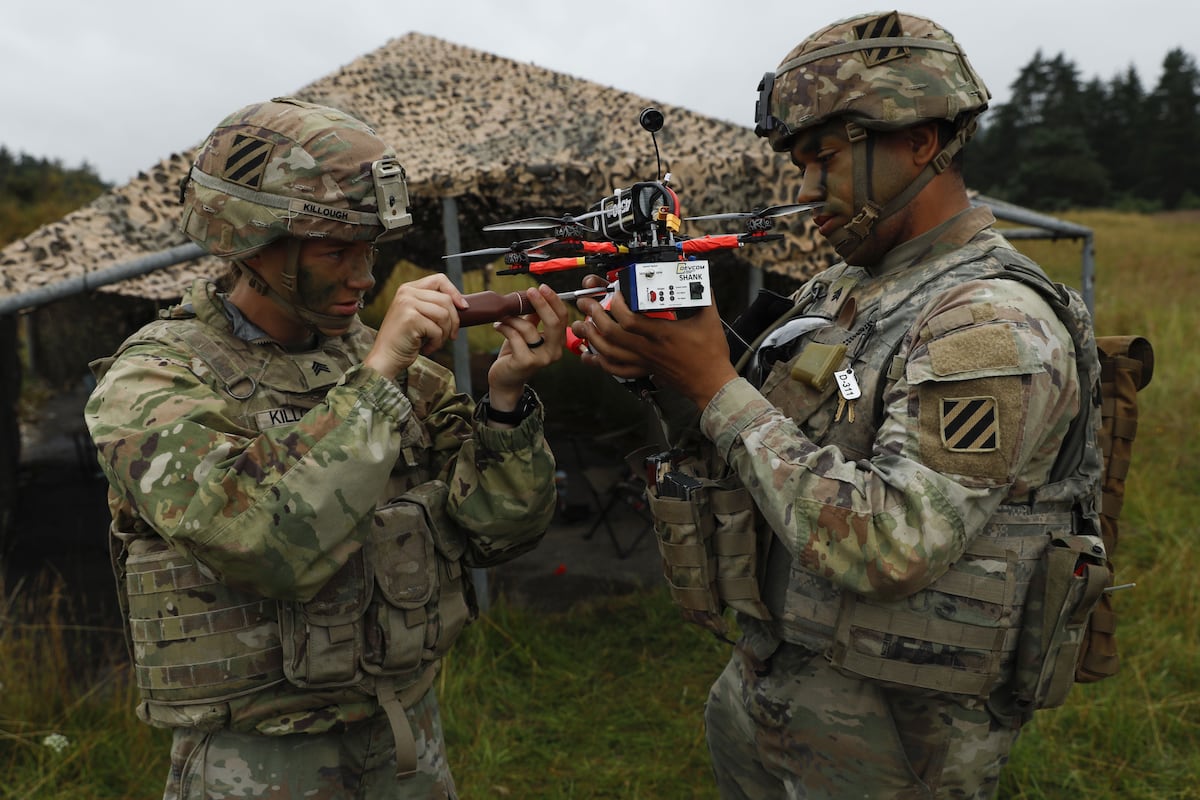Army leaders have learned from recent counter drone experiments that there is no one solution, no silver bullet to protect soldiers from drones.
Leaders from V Corps, Fort Knox, Ky, spoke with reporters on a media call Wednesday to discuss Project Flytrap — an exercise involving U.S. military personnel, partner nation military and industry representatives to help counter the threats posed by unmanned aerial systems on the battlefield.
“[Counter-unmanned aerial systems] are essential to success on the modern battlefield,” said Lt. Gen. Charles Costanza, commanding general of V Corps. ”U.S. and allied forces must rapidly transform to the very real threat of unmanned drones by testing, adjusting and ultimately integrating the best C-UAS platforms in the world to protect our forces. Project Flytrap is a key component of V Corps’ transformation strategy.”
Project Flytrap 4.0 runs from July 27 to 31 at Bemowo Piskie Training Area, near Elk, Poland. It’s the final iteration of counter drone training events with soldiers from the 2nd Cavalry Regiment and the United Kingdom’s 1st Royal Yorkshire Regiment testing new counter drone capabilities.
“Developing, testing and fielding C-UAS technologies together with our NATO allies and partners enhances our deterrence capability,” said Col. Donald Neal Jr., commander of the 2nd Cavalry Regiment. “Training and experimentation with our allies and partners serve to build capacity and increase European leadership in European security, effectively strengthening the NATO alliance.”
More than 40 organizations and 400 industry representatives along with allies and partners from the United Kingdom, Poland and Australia participated.
The first iteration took place in March of this year to identify and test counter drone solutions.
The second phase installed these systems in the U.S. and U.K. formations. The third phase focused on squad and platoon-level counter drone exercises.
This month’s final iteration implemented battalion-level operations with offensive and defensive operations around the clock.
“This pushed the realism factor even higher to maximize the quality of training and feedback,” said Command Sgt. Maj. Eric Bol, command sergeant major, 3rd Squadron, 2nd Cavalry Regiment.
Infantry soldiers completed eight-hour courses over three days, learning to build nearly 300 drones with about a dozen models and how to counter them in the field.
“We made sure those models represented each kind of capability you’d expect to see on the modern battlefield,” Davis said. “Some have thermal optics for nighttime. We used fiber optic drones, jam-resistant, we had larger drones like octocopters. We had six-winged. We really went through a lot of effort to diversify the threat.”
The unit has a drone production and training facility to build drones with 3D printers and learn to fly them.
“I don’t have a huge tech background. I’ve been amazed to see what this unit has been capable of,” Bol said. “I’ve watched soldiers who have an aptitude dive into this and be extremely passionate about it. It’s fun to watch them learn how to build, break and rebuild the drones in the same facility. I have several peers across the Army, in different theaters, and we’re all learning how to fight with UAS, how to defend against them and how to maintain them.”
Fundamentals of infantry tactics still matter as soldiers train with the new drones, said Lt. Col. Jeremy Medaris, commander of 3rd Squadron, 2nd Cavalry Regiment.
“Dispersion, protection, fortification, collecting the correct routes, planning to an objective — they remain essential,” he said. “The essential nature of warfare still matters. Some components are changing, but those fundamental pieces are still there and just as applicable to the counter-UAS fight as well.”
A key takeaway was the need to layer defenses against the drone threat.
“There’s no one system or one solution to counter-UAS,” Neal said. “The counter-UAS capability we’ll have in the future is going to have to be an integrated, multi-system solution.”
During Flytrap, this included a Stryker infantry formation with soldiers wearing radio frequency technology to detect and defeat, jamming drones; soldiers with M4s shooting down enemy drones; and soldiers manning drones from the other side.
“At each echelon, you need the ability to handle that type of data on the systems we use to communicate with,” Neal said. “You have two options: you have the ability to do assault kills, which means you’re altering the flight path without a projectile in the air that shoots it out of the air. Or a hard kill, which means you’re altering the flight path with projectiles. So, it’s neutralized or destroyed.”
Using diversified drones with various capabilities helped with the layering effects.
“If we flew the fiber optics, the RF detect systems we were using, they weren’t going to detect them,” Davis said. “We had to rely on acoustics or an optical, for example.”
Todd South has written about crime, courts, government and the military for multiple publications since 2004 and was named a 2014 Pulitzer finalist for a co-written project on witness intimidation. Todd is a Marine veteran of the Iraq War.
Read the full article here





